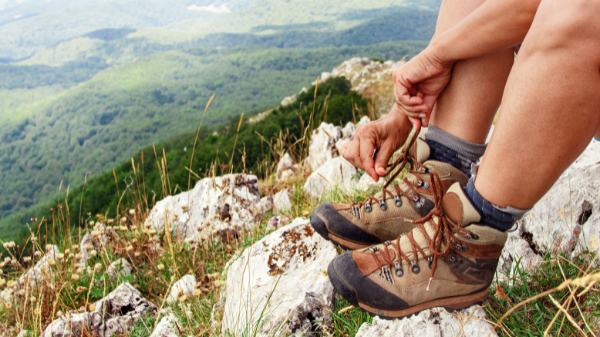After a week of gloomy, rather Scandinavian weather, the sun is finally peeking bright and we’re hoping for a balmy weekend ahead. Setting off on the trails, or pounding the pavements – a strenuous outdoor activity keeping Covid restrictions and the right footwear mind, sounds like just the kind of endorphins we need.

1. Getting the right size
Making sure you have the right size shoe to run or hike in is essential to keeping the feet healthy and comfortable. A common mistake people make is getting a size that matches the length of their feet. Professionals recommend getting shoes a half or full size up to give the toes a comfortable wiggle room, especially since the feet expands as we run. An easy way to tell if you’ve got the right size on is making sure you have a thumb size or two finger size gap from the shoes to your toes and your heel.
2. Choose your shoes according to your trail
Choosing a pair of hiking boots or trail running shoes depends on your objective and trail. A few things to consider: the distance, the terrain and how heavy the load on your back will be. This will determine the right type of footwear for your trail. For example, hiking boots typically have durable outers, rigid soles and high cuts to provide support to the ankles, while also protecting the toes and soles of the feet on rough and rocky terrain in case you trip or slip. On the other hand, casual day hikes or paved paths don’t need high durability and would be a more comfortable experience in lighter shoes made with breathable and flexible material for optimum comfort.

3. Consider how much support or protection you will need
If you are ambitious about tackling challenging slopes, trekking upstream or climbing over rocky terrain, it is crucial to consider how much support, protection and flexibility you will need on your adventure. For easy to moderate flat surfaced hikes, a pair of lightweight, low-cut trail running shoes will offer more flexibility in movement because of its light and springy build. Meanwhile high-cut hiking boots are best fit to serve those trekking unstable trails with loose rocks; they provide good grip and support on the soles and around the ankles, especially for those who are prone to ankle injuries and need the extra support.
4. How heavy is your backpack?
Another thing to consider before picking out a pair of shoes for your adventure is to consider the weight of your load or backpack. With camping becoming a popular hobby for many Hongkongers, particularly for photography enthusiasts, hiking uphill with a full gear can be cumbersome and take a toll on your soles for supporting a lot of the heavy lifting. In this case, hiking shoes (not boots), which are a cross between hiking boots and trail running shoes, provide the lightness and flexibility of trail running shoes while adding stiffer and thicker soles for more comfort and protection.

5. Waterproof is not always best
Contrary to what most people believe, waterproof shoes aren’t necessarily always best for hiking – depending on where you’re going. We say this if you are going on long hikes, your feet are likely to expand and sweat. Breathable materials – preferably mesh – will allow air to flow out through the material, keeping the feet cool and comfortable. However, if you are hiking in water or canyoning, waterproof shoes that have shallow lugs (keeping close contact to the ground) with good grip and flexible material will ensure your feet and you safe and protected.
Also Read: Essential camping gadgets to level-up your next outdoor experience
What to Get

For day hikes and mostly flat surfaces:
Salomon X Ultra 3 Mid GTX: Pros: Built like trail running shoes but with added ankle support and toe protection, stable chassis and lug design as well as a comfortable X Ultra lightweight construction.
La Sportiva’s Nucleo High II GTX: Light, flexible, but impressiely durable and protective with mid-height design and good traction for rocky and muddy trails. It is suitable for day hiking and easy back packing trips. Not only is it waterproof, it lets the air inside exit through the top and bottom thanks to its web-like mesh design along the sides.
For trail running or climbing:
Hoka One One Speedgoat 4: Plush cushioning with grippy and comfortable soles and is extremely lightweight but soles wear down easily.
La Sportiva TX4: Categorised as Approach Shoes, this pair allows its wearers to move fast while trekking lightly and flexibly yet still offer a comfortable and supportive construction for challenging trails or for rock climbing.
For backpacking and uneven terrain:
Salomon Quest 4 GTX: Provides great ankle support and protection, and has durable upper, cushioning and protective underfoot that keeps the feet comfortably supported and safe from rough terrain.
La Sportiva Spire GTX: Sturdy and with good stiffness and thick midsoles that protects the feet from rocky trails. Has good grip built for long hikes and for climbing objectives.
Scarpa Zodiac Plus GTX: Durable for backpacking over rough terrain, but is still reasonably light (2lbs) and pretty flexible. Can provide enough comfort to cover ground for days while keeping the feet and protected in rocky, snowy or wet conditions.
Also Read: Catch the most beautiful sunrise on these Hong Kong hikes



